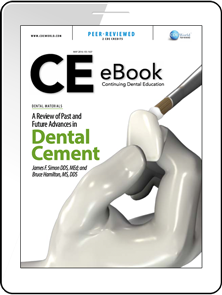A Review of Past and Future Advances in Dental Cement
Released: Wednesday, May 18, 2016
Expires: Tuesday, April 30, 2019
By James F. Simon, DDS, MEd; and Bruce Hamilton, MS, DDS
Commercial Supporter: Kuraray Dental
Over the years, dentistry has gone through numerous cements and techniques searching for the ideal cement. Many of dentistry’s newest restorations require that they be bonded, therefore resin cements are now commonly used in restorative dentistry, partly because of the restoration material and partly because of the trend toward minimally invasive, non-retentive preparations. These two factors have led to the introduction of the adhesive resin cements. This article will review some of the newly evolved resin cement systems, presenting the advantages and disadvantages of each. The newest bioactive cements, meaning that they induce repair and regeneration in tooth structure, are also discussed.
LEARNING OBJECTIVES:
-
Define each of the descriptors for cementation techniques.
-
Discuss the advantages and disadvantages of the new resin cements.
-
Describe the dental adhesive model that uses biologically inert materials to attach a tooth to a crown.
About the Authors
Dr. Simon is a professor in the Department of Restorative Dentistry at the University of Tennessee Health Sciences Center College of Dentistry.
Dr. Hamilton is an assistant professor in the Department of Restorative Dentistry at University of Tennessee Health Sciences Center College of Dentistry.
